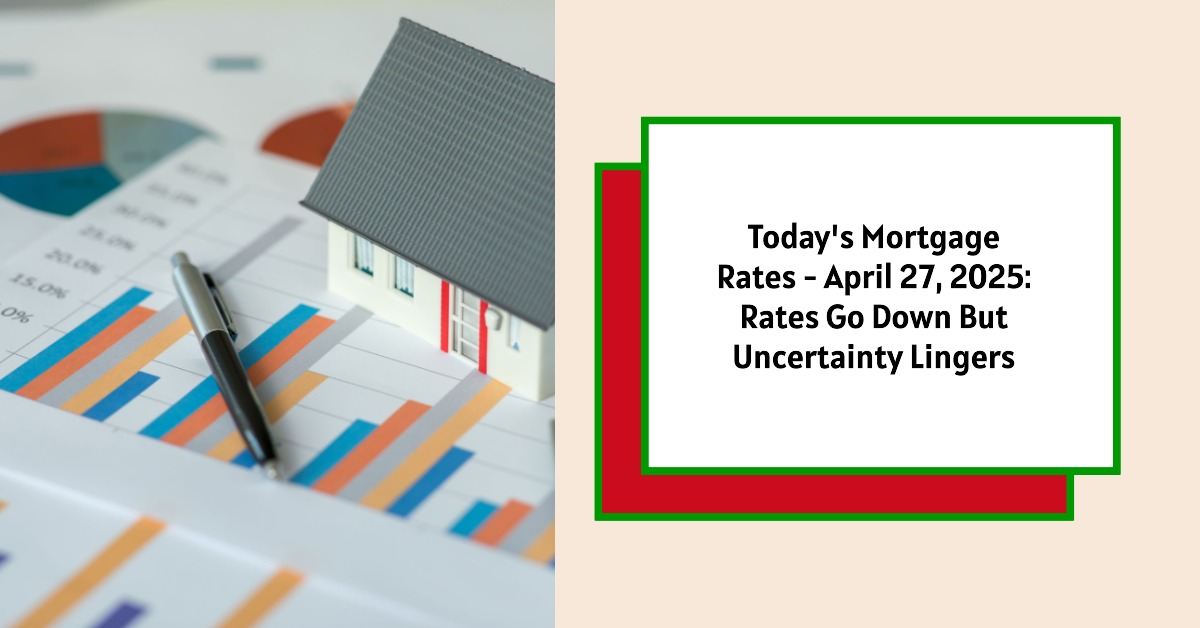As of April 27, 2025, mortgage rates have decreased compared to last week, making it a potentially advantageous time for homebuyers and those considering refinancing. Current average mortgage rates show a notable reduction, with the 30-year fixed rate at 6.71%, down from previous peaks. According to data from Zillow, the average 15-year fixed rate is at 6.00%, signifying a drop of 11 basis points. This decline could encourage many to ponder purchasing a new home or refinancing their existing loans.
Today's Mortgage Rates – April 27, 2025: Rates Go Down But Uncertainty Lingers
Key Takeaways
- Mortgage rates have decreased: Average 30-year fixed rate at 6.71% and 15-year fixed at 6.00%.
- Refinance rates are down too: 30-year refinance fixed rate at 6.72%.
- Rates are still higher than earlier this month and could fluctuate based on upcoming economic reports.
- The Fed’s response to the economy is crucial in determining future interest rates.
- Always shop around for the best rates and terms from lenders.
Understanding Today's Mortgage Rates
Mortgage rates are a crucial factor for homebuyers and those looking to refinance. The rates not only affect monthly payments but also the overall cost of a loan over its lifetime. As we explore current mortgage and refinance rates, it's essential to understand the broader context influencing these numbers.
Current Mortgage Rates
On this date, the average mortgage rates as reported from Zillow are as follows:
| Loan Type | Current Rate |
|---|---|
| 30-Year Fixed | 6.71% |
| 20-Year Fixed | 6.39% |
| 15-Year Fixed | 6.00% |
| 5/1 ARM | 7.30% |
| 7/1 ARM | 7.31% |
| 30-Year VA | 6.23% |
| 15-Year VA | 5.73% |
| 5/1 VA | 6.37% |
This data reflects national averages and is rounded to the nearest hundredth. Always remember that rates can vary significantly based on lender, location, and individual financial circumstances. It's also important to note that mortgage lenders often offer different rates and terms, so shopping around can lead to substantial savings.
Mortgage Refinance Rates
Refinancing can adjust your mortgage terms and potentially save you money every month. Here are the latest refinance rates:
| Refinance Loan Type | Current Rate |
|---|---|
| 30-Year Fixed | 6.72% |
| 20-Year Fixed | 6.34% |
| 15-Year Fixed | 6.10% |
| 5/1 ARM | 7.60% |
| 7/1 ARM | 7.49% |
| 30-Year FHA | 6.32% |
| 15-Year FHA | 5.85% |
| 5/1 FHA | 6.31% |
Notably, refinance rates are typically slightly higher than purchase rates, but both are experiencing a decline, making this an opportune moment for many homeowners.
Why Mortgage Rates are Down
The recent decrease in mortgage rates comes after a period of fluctuation where rates approached the 7% mark last week. There are several factors at play:
- Economic Reports: Investors are awaiting crucial economic indicators, including inflation and job reports, which can heavily influence the Federal Reserve's decisions on interest rates. If inflation remains stable, there’s a chance rates could drop further.
- Fed's Interest Rate Policies: Current market conditions indicate that the Federal Reserve is cautious. While they have hinted at rate adjustments, they also want to assess the economic impact of ongoing trade policies. Federal policies can lead to expected reductions in rates in the upcoming months, which may further influence mortgage rates in a downward direction. Recent statements from Fed Chair Jerome Powell emphasize a careful approach to cutting rates, which suggests that while changes may occur, they will be measured.
- Housing Demand: As rates drop, more homebuyers might enter the market, thereby increasing the demand for housing. This demand can create a balance in the housing market, influencing future loan rates. Moreover, as potential buyers feel confident about lower rates, we could see a noticeable uptick in home sales, which in turn may stabilize or even increase housing prices.
Fixed-Rate vs. Adjustable-Rate Mortgages
When considering mortgage options, understanding the difference between fixed-rate and adjustable-rate mortgages (ARMs) is crucial.
- Fixed-Rate Mortgages: These loans have a set interest rate that does not change over the life of the loan, making it easier to budget for monthly payments. For example, a 30-year fixed loan at 6.71% ensures that your rate is locked in and will not fluctuate. This stability is particularly appealing to many homeowners who prefer predictable expenses.
- Adjustable-Rate Mortgages: With ARMs, the initial interest rate is typically lower than that of a fixed-rate mortgage, but the rate can change after a set period, leading to potential increases in future payments. For instance, a 5/1 ARM might start lower but could adjust higher after five years based on market rates. This offers both risk and potential reward, as if market rates go down, the homeowner can benefit from lower payments.
When making a decision between these two types, it's vital to consider how long you plan to stay in your home, your tolerance for risk, and your comfort level with potential payment changes in the future.
Example Calculations
Let’s delve into some illustrative examples comparing fixed-rate options.
Scenario: Consider a homebuyer seeking a mortgage of $300,000.
- 30-Year Fixed Mortgage at 6.71%:
- Monthly Payment (Principal + Interest): ≈ $1,938
- Total Interest Paid Over 30 Years: $397,617
- 15-Year Fixed Mortgage at 6.00%:
- Monthly Payment (Principal + Interest): ≈ $2,532
- Total Interest Paid Over 15 Years: $155,683
The trade-off between these options reflects the balance between lower payments spread over a longer period versus higher monthly payments with a significant amount saved in interest. By choosing a 15-year term, borrowers significantly reduce their interest costs, although their monthly budget will feel tighter due to the higher payments.
The Future of Mortgage Rates
Looking ahead, many experts project a gradual easing of mortgage rates throughout the year, but certainly not back to the historic lows seen in 2020 and 2021. According to Fannie Mae's March 2025 commentary, the forecast for the end of 2025 is 6.3% for the 30-year fixed mortgage. This reflects a consensus that while rates will remain higher than in previous years, they will stabilize as inflation trends balance out.
Additionally, Freddie Mac's Housing and Mortgage Market Outlook suggests that while some buyers and sellers are hesitant due to high rates, the lack of expected significant declines may motivate them to enter the market sooner than they might have otherwise. This could lead to an increase in transaction volumes, affecting the overall housing supply and potentially stabilizing prices.
Economic Impact on Mortgage Rates
The Federal Reserve's ongoing evaluation of the economy plays a pivotal role in determining future interest rates. Interest rates are mainly driven by inflation metrics, job growth, and overall economic health. As the Fed navigates these parameters, their policies directly impact mortgage availability and affordability.
For instance, if the economy shows signs of slowing—evidenced by a troubling jobs report or stagnant GDP—there's potential for rate cuts to stimulate growth. Conversely, if inflation ticks higher than anticipated, it could prompt an increase in rates to curb spending.
Thus, it remains essential for individuals to consider not just current rates but also the overarching economic climate in making their home financing decisions.
Read More:
Mortgage Rates Trends as of April 26, 2025
Mortgage Rates Drop for the Second Day in a Row
When Will the Soaring Mortgage Rates Finally Go Down in 2025?
Why Are Mortgage Rates Rising Back to 7%: The Key Drivers
Key Factors Influencing Mortgage Rates
Apart from the Federal Reserve's actions and economic reports, several factors can affect mortgage rates:
- Inflation: Higher inflation generally leads to higher interest rates. Lenders want to ensure that they are compensated for the decreasing purchasing power of future payments.
- Employment Data: Strong job growth can signal a healthy economy, which may lead to rising interest rates as the Fed works to combat inflation. Conversely, weak employment data can lead to rate cuts to stimulate borrowing and spending.
- Bond Market: Mortgage rates are closely linked to the performance of the bond market. When the yield on the 10-year Treasury bond rises, mortgage rates tend to follow suit.
- Consumer Confidence: High confidence levels tend to correlate with increased spending and borrowing, driving rates higher. When consumers are uncertain, demand decreases, potentially leading to lower rates.
- Supply and Demand: The dynamics of housing supply and demand can also impact mortgage rates. In a seller’s market, where demand exceeds supply, lenders may raise rates due to increased competition for available properties.
- Global Events: Global economic conditions, geopolitical tensions, and even pandemics can influence U.S. mortgage rates. Investors often look for safe havens in such times, impacting demand for bonds and, in turn, mortgages.
Conclusion on the Current Mortgage Landscape
In this climate of fluctuating mortgage rates, understanding the nuances of the options available is key for any potential homebuyer or homeowner looking to refinance. As of today, April 27, 2025, the decrease in mortgage rates provides a favorable outlook for many. However, it's crucial to remain informed about upcoming economic reports and trends to navigate this landscape effectively.
The interplay of various economic factors, Federal Reserve policies, and market dynamics means that mortgage rates will likely experience ups and downs throughout the year. Staying attuned to these fluctuations can help savvy consumers make informed decisions when it comes to their most significant financial investments.
Turnkey Real Estate Investment With Norada
Investing in real estate can help you secure consistent returns with fluctuating mortgage rates.
Despite softer demand, smart investors are locking in properties now while competition is lower and rental returns remain strong.
HOT NEW LISTINGS JUST ADDED!
Speak with an investment counselor (No Obligation):
(800) 611-3060
Also Read:
- Will Mortgage Rates Go Down in 2025: Morgan Stanley's Forecast
- Expect High Mortgage Rates Until 2026: Fannie Mae's 2-Year Forecast
- Mortgage Rate Predictions 2025 from 4 Leading Housing Experts
- Mortgage Rates Forecast for the Next 3 Years: 2025 to 2027
- 30-Year Mortgage Rate Forecast for the Next 5 Years
- 15-Year Mortgage Rate Forecast for the Next 5 Years
- Why Are Mortgage Rates Going Up in 2025: Will Rates Drop?
- Why Are Mortgage Rates So High and Predictions for 2025
- Will Mortgage Rates Ever Be 3% Again in the Future?
- Mortgage Rates Predictions for Next 2 Years
- Mortgage Rate Predictions for Next 5 Years
- Mortgage Rate Predictions: Why 2% and 3% Rates are Out of Reach
- How Lower Mortgage Rates Can Save You Thousands?
- How to Get a Low Mortgage Interest Rate?
- Will Mortgage Rates Ever Be 4% Again?


